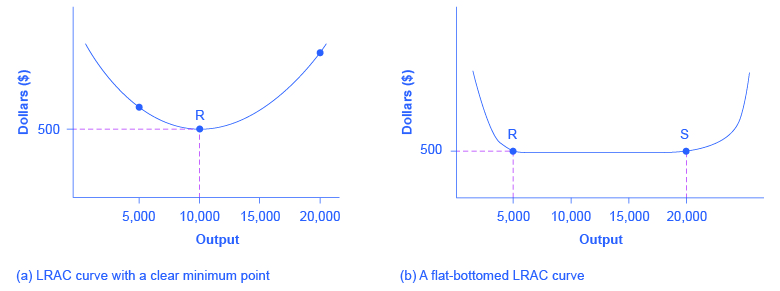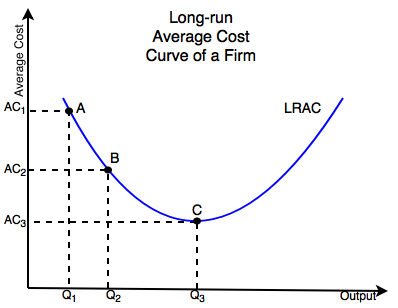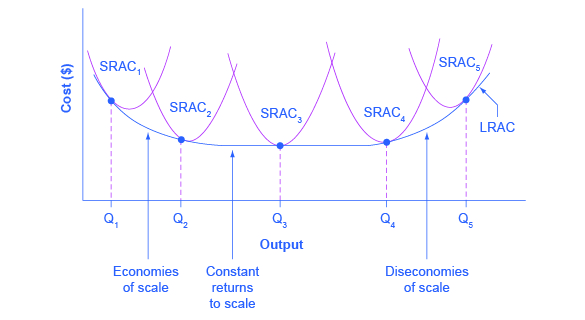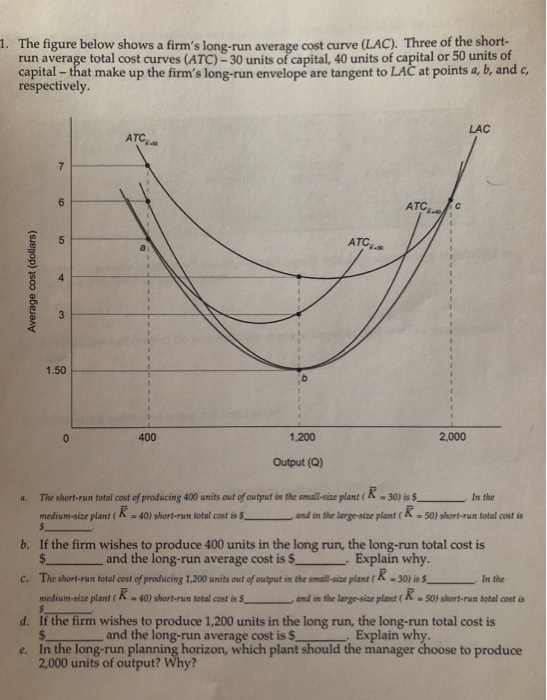A Firm's Long-run Average Cost Curve Is
Economies of scale occur when an equal percentage increase in all factors of production results in a greater percent increase in output --eg. Now what is the proper explanation of such behaviour of the long- run average cost curve.

Solved The Figure Below Shows A Firm S Long Run Average Cost Chegg Com
This curve is obtained by drawing a line which touches the series of possible short-run cost curves.
. The minimum point on the SAC curve. On the left at the point where the LRAC curve has zero slope the firm is experiencing constant returns to scale. Both relatively small and relatively large firms can be viable in the industry.
This is because a firm plans to produce an output in the long run by choosing a plant on the long run average cost curve corresponding to the output. The LRAC curve assumes that the firm has chosen the optimal factor mix as described in the. It helps the firm decide the size of the plant for producing the desired output at the least possible cost.
A firms long-run average cost LAC curve is downward sloping. Always rises as output increases. Their behavior differs according to the element of time.
See the answer See the answer done loading. The industry will be a natural monopoly. CM is the minimum cost at which optimum output OM can be obtained.
The long run average cost is a U shaped curve. Long run average cost is the cost per unit of output feasible when all factors of production are variable. It is generally believed by economists that the long-run average cost curve is normally U shaped that is the long-run average cost curve first declines as output is increased and then beyond a certain point it rises.
4 A firms long-run average cost curve is. Each time the scale of operation changes a new average cost curve will have to be drawn for the firm. Decreasing returns to scale B.
B the locus of points made up of the minimum point on each short-run average total cost curve when only. Graphically LAC can be derived from the Short run Average Cost SAC curves. A firms long-run average cost curve decreases over a range of output because of Select the best answer below.
Is the sum of a firms short run average cost curves. Long-run average cost curve of a firm depicts the minimum average cost at which the firm can produce any given level of output in the long run. Each short-run average cost SAC curve will be tangent to the LAC curve at A.
It can be calculated by the division of LTC by the quantity of output. Technology precludes both economies and diseconomies of scale. A point to the left of the minimum of the SAC curve.
The minimum point of the LAC curve. Short run is the run during which a firm can increase its output by changing the variable factors of production. What gives the long run average total cost curve its U shape are the concepts of economies of scale constant returns to scale and diseconomies of scale.
10 more workers and a 10 bigger factory results in 15 more tacos being made. The long-run average cost curve is used in most meetings where all operations of a firm are being considered and are in the process of being optimized for low cost and high returns. Diminishing marginal returns E.
The long-run average cost LRAC curve shows the firms lowest cost per unit at each level of output assuming that all factors of production are variable. The graph depicts the average total cost curve for a perfectly competitive firm. In the long run all costs are assumed to be variable.
On the other hand long run is the run suitable for a firm to increase its. Look at the figure given below. Next Marginal Cost in Economics.
The long run average cost curve A. Always falls as output increases. Click to see full answer.
Diminishing marginal returns C. 20 ATC 15 10 5 o Q 80 10 20 30 40 50 60 70 is 40. Mathematically speaking LRAC is the envelope of U 1 U 2 U 3 etc.
In the long run all inputs are variable. In this figure 137 the long-run average cost curve of the firm is lowest at point C. Mathematically expressed the long-run average cost curve is the envelope of the SAC curves.
If an industrys long-run average total cost curve has an extended range of constant returns to scale this implies that. Long run average cost LAC can be defined as the average of the LTC curve or the cost per unit of output in the long run. While the traditional shape of the Long-run cost curve is U shape the modern curve is more favourable to the L shape because technology allows for better optimization of new and old.
The effect is to reduce average costs over a range of output. At the long-run equilibrium level of output this firms total revenue. A point to the right of the minimum of the SAC curve.
The Long Run Average Cost LRAC curve of a firm shows the minimum or lowest average total cost at which a firm can produce any given level of output in the long run when all inputs are variable. 4 A firms long-run average cost curve is A the locus. Shows the lowest average cost facing a firm as it increases output changing both its plant and labor force.
The long-run cost curve is a curve which shows how costs change when the scale of production is changed. The long-run average cost LRAC curve shows all possible outputs in the long run. The long-run cost curve is the locus of equilibrium point on the short-run cost.
Initially rises when output increases and then falls when output increases. Economies of scale are the unit cost advantages from expanding the scale of production in the long run. Long-run average cost LRAC refers to per unit cost incurred by a firm in the production of a desired level of output when all the inputs are variable.
The long-run average cost curve LAC is the envelopes of the various short-run average cost curves. 75 LRAC is such a line. A the locus of points representing the minimum unit cost of producing any given rate of output when all inputs may be adjusted.
A long run average cost curve is known as a planning curve. The point of efficient scale is the point on the long-run average cost LRAC curve where average cost for a firm is at the minimum. The cost curves of a firm in the short run and in the long run are not same.
Cannot be determined from the information provided. Increasing returns to scale. When all factors of production can be used in varying proportions the scale of operations can be altered.

Long Run Average Cost Curve Derivation Example Solved Questions Etc
Economics In Plain English From Short To Long Economies Of Scale And The Long Run Average Total Cost Curve

Solved The Graph On The Right Shows The Long Run Average Chegg Com
Why Is The Long Run Average Cost Not Tangent To The Minimum Point Of Short Run Average Cost Curves Quora

7 3 The Structure Of Costs In The Long Run Principles Of Economics
Why Is The Long Run Average Cost Curve U Shaped Quora

The Relationship Between Shortrun And Long Run Average Total Cost Economics Assignment Help Economics Homework Economics Project Help

Reading Short Run And Long Run Average Total Costs Microeconomics

Section 6 The Long Run Average Cost Curve Inflate Your Mind

Long Run Supply Overview Total Cost Curves Returns To Scale
/MinimumEfficientScaleMES2-c9372fffba0a4a1ab4ab0175600afdb6.png)
Minimum Efficient Scale Mes Definition

Solved 5 The Long Run Average Cost Curve Aa Aa The Chegg Com

Economies Of Scale Energy Education
Economics In Plain English From Short To Long Economies Of Scale And The Long Run Average Total Cost Curve

7 3 The Structure Of Costs In The Long Run Principles Of Economics

Solved I The Figure Below Shows A Firm S Long Run Average Chegg Com

Long Run Average Cost Curve Derivation Example Solved Questions Etc

Comments
Post a Comment